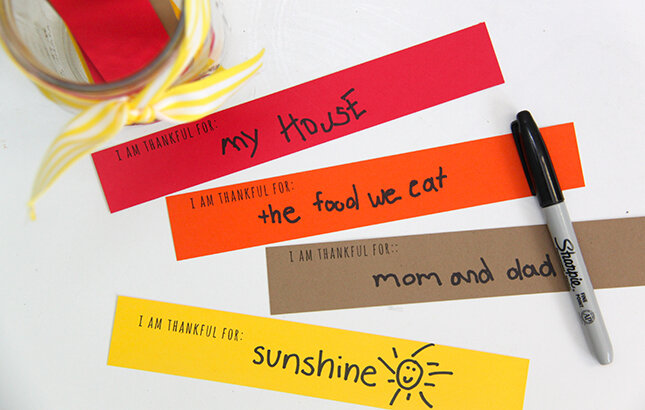I think we can all agree that 2020 hasn’t been a typical year! As we continue to adapt to this “new abnormal,” we also have the amazing opportunity to notice and acknowledge the many moments of goodness, light, peace, and fulfillment.
This month, join us in a reflective practice of gratitude as we share more about how actively giving thanks can improve your health and happiness. We’ve included some of our favorite gratitude traditions that you can practice with you family and invite you to join our #30DaysOfGratitude Challenge!
The Science of Gratitude
You may have heard that practicing gratitude has actually been scientifically proven to enhance happiness, improve health, and boost well-being when done consistently.
Here are some of the outcomes from practicing gratitude according to Psychologist and gratitude researcher, Dr. Robert Emmons and his team:
Physical
Stronger immune systems
Less bothered by aches and pains
Lower blood pressure
Exercise more and take better care of their health
Sleep longer and feel more refreshed upon waking
Psychological
Higher levels of positive emotions
More alert, alive, and awake
More joy and pleasure
More optimism and happiness
Social
More helpful, generous, and compassionate
More forgiving
More outgoing
Feel less lonely and isolated.
Gratitude Starts With Acknowledgment
While all of these benefits are convincing enough, intentionally practicing gratitude has taught me something even more compelling that has made me think of thankfulness in a new way.
Gratitude starts with acknowledgement. And when practiced regularly, it develops authenticity and integrity, ultimately building positive relationships within yourself and others.
LESLIE M. BOSSERMAN
Think of the last time someone genuinely acknowledged WHO you are, not just WHAT you’ve done. What was the impact? When you proactively appreciate others at work or at home, you add value to your relationships AND it feels good! You can acknowledge what you are thankful for as well as the people in your life that make it better. Here are two examples:
Modeling Gratitude at Work: When a colleague or your supervisor does something noteworthy, make a point to share the impact of their actions with them, especially if you see it positively affecting others on your team or in your workplace. This is particularly important if you are managing a team and developing young talent.
Example: I really appreciated your advocacy and support on this project and can see how your leadership has really boosted morale on our team!
Practicing Gratitude at Home: Parenting is often so functional that we can miss moments of acknowledgement. Take time to specifically acknowledge your family members for their character, not just their behavior.
Example: Wow! I love how kind and thoughtful you were when you shared your toy with your brother” instead of just saying “Good job sharing.”
The simple shift from expressing gratitude for someONE rather than for someTHING, makes all the difference!
LESLIE M. BOSSERMAN
Practicing Gratitude
Now that we know the reasons why we should cultivate more gratitude in our lives, here are some simple and fun ways to get your entire family involved!
Family Gratitude Reflection
Gather your family together, even if you have littles who can’t write or talk yet. Start by verbally reflecting on what you are grateful for in your life and make your gratitude list. Consider what is…
supportive
peaceful
helpful
fruitful
working
wonderful
For parents of older kids, give everyone a piece of paper and pencil and set a timer for 2 minutes and have everyone write down or draw pictures of what they are grateful for. Then go take turns sharing your gratitude lists, one item at a time, until you’ve read all of them out loud as a family. You can take this activity to the next level with the activities listed below.
Visual Gratitude Displays
There are many ways to visually display your family’s gratitude list:
Gratitude Pumpkin: Pick out a larger size pumpkin that will become your family’s gratitude pumpkin. Using permanent markers (we love using lots of colors!), have each person write what they are thankful for on the outside of the pumpkin to create a visual display of gratitude.
Paper Pumpkin: Alternatively, you can use strips of orange construction paper and write what you are thankful for on each strip. To create a paper pumpkin, glue or staple the strips together at the top and bottom so they form a sphere shape. Then you can use green construction paper to add a stem or even trace your child’s hand to form a creative leaf!
Gratitude Chain: You can also create a paper chain with items you’re grateful for and connect the circles to form a fun visual display to decorate your home.
Grateful Jar: Using a large clean jar, write what you are grateful for on larger popsicle sticks and put them in a jar so you can pull them out when you need a reminder! You might choose to decorate your jar with autumn colored tissue paper, Mod Podge, and add a turkey face with googly eyes to make a festive table decoration!
Thanksgiving Tablecloth: If you are gathering together for a special Thanksgiving meal, it’s also fun to buy a tablecloth that you can write your gratitude lists on. There are single-use paper versions that you can color and toss when you’re done, or heavier-duty reusable options if you want to carry on this tradition and continue addition to the tablecloth from year-to-year.
#30DaysOfGratitude Challenge
Throughout the month, we invite you to join us as we publicly share our gratitude lists. Choose one thing a day to be grateful for and share a post or photo on social media with the hashtag #30DaysOfGratitude and #MakersPlaceSac so we can follow along!









